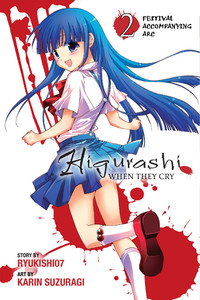Review
by Rebecca Silverman,Higurashi: When They Cry
GN 23 - Festival Accompanying Arc 2
| Synopsis: |  |
||
With Satoko approaching a crisis as her Hinamizawa Syndrome reaches dangerous levels, Dr. Irie must come to a difficult decision about whether he wants to listen to the increasingly heartless Takano or his own conscience. Meanwhile Rika does all she can to help both the situation and to prevent her own death when June of 1983 rolls around. Takano isn't pleased with any of this, and as her frustration grows, we learn about what really happened to Rika's parents, Satoko's parents, and Satoshi...and the Cotton Drifting is almost here. |
|||
| Review: | |||
Usual Spoiler Warning: If you're not caught up with the previous volume, you may not want to read this! Miyo Takano has a problem – or rather, she has two: one she is aware of and obsessed with, and one that we the readers can pinpoint. The former has to do with her manic need to prove her adoptive grandfather's research on Hinamizawa Syndrome, a disease caused by a brain-altering parasite, is real. To this end, she has moved to the idyllic town of Hinamizawa, opened the Irie Clinic, and obtained a government-backed source of funding in order to research the disease and its potential uses as a chemical/biologic weapon. The previous omnibus in the Festival Accompanying Arc showed us the root of her own personal madness in her troubled (and traumatic) childhood, which she seems to see as a one-on-one battle with God. Now in this second omnibus, we begin to see what happens when her world once again begins to crumble. From a series point of view, this transition is fascinating because it finally begins to provide us with hard answers – we now know what is behind Oyashiro-sama's so-called curse, as well as what happened to those who “died” and “disappeared.” But more interesting is the change in Takano herself. She has been theorizing, alongside her deceased and discredited grandfather, that Hinamizawa Syndrome can cause illusions and paranoia that might lead to the belief in gods, the foundation of religion. This implies that she believes higher powers to be, on some level, fictitious. What, then, does it say that she continually sees herself as being in competition with God, that she speaks to God, that she can see Oyashiro-sama/Hanyu? Wouldn't that suggest that she has somehow contracted Hinamizawa Syndrome herself? Ryukishi07 never says as much, only implies it through between-the-lines interpretation of the text and images. But the possibility is a tantalizing one, and it could certainly have an interesting effect on Rika and Hanyu's endgame. That begins to be put into play in the latter half of the volume, when Hanyu reveals more of her past and we learn who and what she is and has been. Her decisions at this point are all made in the goal of saving Rika's life and breaking the cycle of hundreds of years, and to that end she begins to pull out the stops. A quick glance at the cover for the next volume will reveal part of what she plans to do, or rather, who she plans to involve, but it is the how, not so much the who and what, which make it particularly interesting. The idea of an endless time loop straining to break is becoming increasingly solid, and with Hanyu's growing determination, the story continues to gain in urgency. As has been the norm with the Festival Accompanying Arc, narration continues to be shared among the cast. This volume puts us in the first-person perspectives of a variety of surprising characters, including Keiichi's father and Oiishi, the detective from Okinomiya. Once again we are brought back to World War Two as the root of someone's anguish and issues, reminding us that the past very rarely stays where it has fallen. The intertwined nature of the past and the present seems to have an increasing role in the story, although just what that foretells has not yet become clear. This is one of the busiest volumes in the Higurashi: When They Cry series. With the constant narrative shifts and the rush to get to 1983, it can feel like it is trying to cover too much too quickly in places, and a few reveals lack impact because of it. Keiichi's entrance on the scene feels a bit rushed, particularly for something so important to the outcome of the story. Karin Suzuragi's usual anatomical issues are at play, but her horror scenes remain top-notch, particularly when Takano is involved. The binding is a little tighter on this volume than in earlier omnibuses, which makes it a bit harder to open fully without cracking the spine, but the translation remains excellent and the usual color pictures are present in the beginning of the volume. Higurashi: When They Cry is still an intriguing, spine-chilling, gut-churning horror/mystery hybrid that has nicely recovered from the prologue feel of the previous volume. It can be an intimidating series to pick up, knowing how long and convoluted it is, but as things begin to come to a head and a close at the same time, it looks as if those who stuck by it are about to be amply rewarded...when the Cotton Drifting comes. |
| Grade: | |||
|
Overall : A-
Story : A-
Art : A-
+ Answers are provided while more are hinted at, making this very satisfying. Great horror imagery and shifting the point of view to new characters helps to give a rounder perspective on the story. |
|||
| discuss this in the forum (7 posts) | | |||
| Production Info: | ||
|
Full encyclopedia details about Release information about |
||